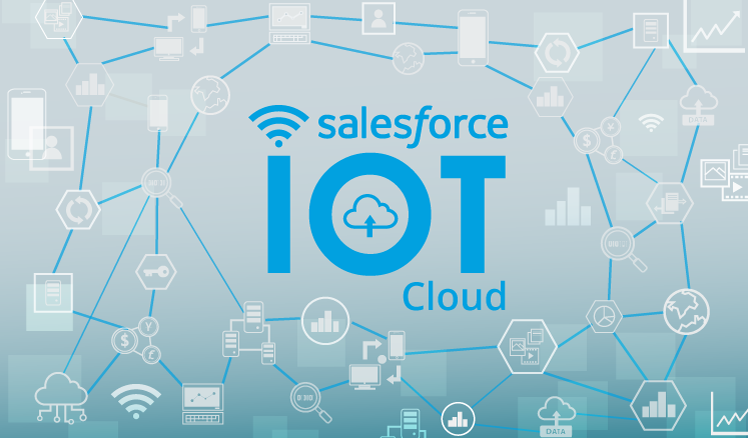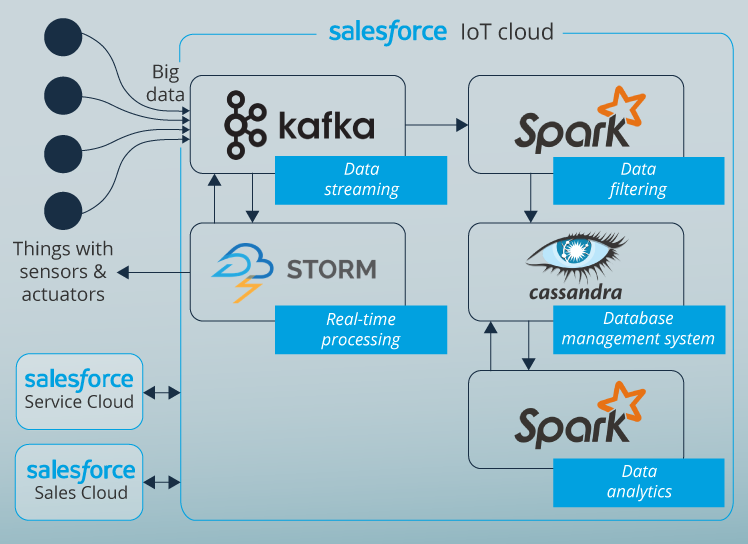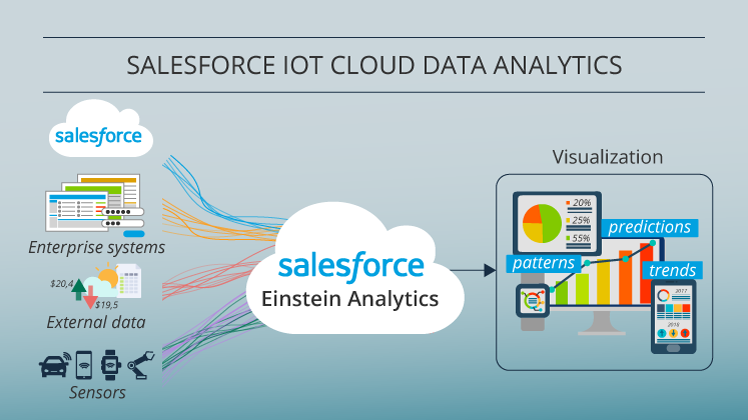Salesforce IoT Cloud: benefits and limitations
Editor's note: We prompt you to reimagine the way you build customer experience and use IoT capabilities for that. Consider our IoT consulting services to plan a solution similar to the one described in our article but tailored specifically to your needs.
Let’s consider the perspective that every user of connected things is a customer of a things’ manufacturer and a company maintaining these things. With a prudent approach, big data generated by these things can become a valuable source of info for product and service providers: how customers are using products and services, what is the current state of every product, which features and services should be added or removed, how to increase customer satisfaction.
Many enterprises have already discovered the benefits of CRM systems to manage customer-related activities. With the Internet of Things, such systems could bring even more value gathering and processing continuous streams of all-side data from customers’ connected devices which was not accessible before. Salesforce, one of the leaders in customer management solutions, also embarks on exploring IoT potential.
In our new article, we shed some light on this topic basing on our experience in Salesforce consulting.

Salesforce approach to IoT
The idea of Salesforce is to enrich the provided services with the benefits of the big data collected from connected devices and enable CRM users (not prepared for serious coding) to build and customize their own apps to manage these data.
To store and process such data, Salesforce provides the platform called Salesforce IoT Cloud. It is powered by Thunder which is an event-processing engine designed to capture, filter and respond to events in real time. Thunder is built on open source tools:
- Apache Kafka (a messaging system that can handle huge volumes of reads and writes per second)
- Apache Storm (real-time big data and event processing platform).
- Apache Spark (distributed large-scale data processing framework for both batch and streaming data)
- Apache Cassandra (distributed database management system).
Incoming data are dumped into Kafka. Spark takes the profile data from Kafka and puts it into Cassandra for profile updates. Storm uses the data from Kafka to handle real-time events.
These technologies are run on Salesforce’s own Heroku PaaS that maintains the development environment and integrates other cloud services. Connected devices are managed by Amazon Web Services, while big data is transferred from sensors to the Salesforce IoT Cloud and from the Cloud to control applications and actuators with RESTful API.

Ingesting sensor data
Gathering big data from customers’ connected things is the 1st step to meaningful insights. However, for valuable data analytics, it can be useful to consider not only the data from connected devices but also a customer’s location, purchase order history, case history and other parameters.
In this respect, one significant feature in Salesforce IoT Cloud is focusing on customer context – the environment in which customers take actions. Customer context can be used in stream processing and contribute to generating better real-time responses. The data (both customer actions and context) is stored and then used for deep data analysis and machine learning. As the matter of fact, raw data is stored in a data lake, while a big data warehouse is used to collect filtered and preprocessed data (as well as the information about sensors – their location, status and more). The functionality of Thunder enables users to set filters to identify relevant data from data streams.
Data analytics
Salesforce IoT Cloud ingests billions of events per day, and data processing tools are an important architecture component to focus on in IoT solution development.
To enhance data processing, Salesforce uses Einstein Analytics – business analytics software built entirely in the cloud. Einstein Analytics helps CRM users uncover insights from huge sets of data including not only sensor data, but also relevant ERP records, website logs and more. Exploring the data from Salesforce and external sources (for example, energy prices, traffic schedules, weather forecasts), CRM users can get expanded picture of how the products and services are used, trace trends and even make predictions. Einstein automatically picks the best way of visualization (be it charts, metrics, diagrams or other means) and prompts users to create a story – to make the reports easy to read, understand and remember.

Einstein Analytics is optimized for tablets, phones and even watches. Einstein Analytics users can build and customize their own analytics apps using prebuilt dashboard components. Salesforce also offers an online training to help users to learn more about this tool.
Integration with enterprise applications
Although Salesforce IoT Cloud can be used as a standalone service for data storing and processing, it also has the connectors to integrate with other Salesforce products or third-party systems a company uses. Such integration ensures stable flow of meaningful data from various sources and between multipurpose corporate systems. With all these data, Einstein Analytics can give all-round reports and make meaningful conclusions from all available information about customers, products and services.
Connecting data to customer experience
The data from customers’ connected things can be used to improve customer management. Thus, using rule-based approach, control apps can send service notifications: sensors get the data about the real-time state of a product, compare these values to the ones stored in the app’s local database as acceptable and notify in advance that a product will need servicing. With machine learning-based controlling, the data from customers’ connected things can be regularly used to update an IoT system. For example, Einstein Analytics can help identify which patterns of using a product most frequently lead to its damage and inform the users when their actions can have unfavorable impact on a product.
Another example is Salesforce IoT Cloud for retail stores. With connected sensors, retailers can monitor the conditions in which the goods are transported and stored, identify which products are currently in stock and whether additional supplies are needed. As the info about customer preferences in various regions is accommodated, it’s possible to identify which regions need more of particular goods.
Discovering new pricing and business models
Gathering and analyzing the data from the connected things, enterprises get the expanded context of how customers are using their products and services and how effective these products and services are. With all these data, enterprises can spot opportunities to optimize current business operations (for example, in marketing, logistics), offer new and cost-effective cooperation models and plans of using products and services to customers and even uncover new more profitable business models.
Some points of concern
The benefits of the Salesforce IoT Cloud open new transformation opportunities that look rather promising. However, there are some limitations and concerns that may hamper Salesforce implementation and adoption.
1. Security vulnerabilities
Huge volumes of data mean not only expanding customer profiles, but also the necessity to protect these data. Big data from customers’ connected things can be stolen and used by competitors and cybercriminals. It generates additional concerns about how to secure data and connections, introduce effective but not tedious procedures of device and user identification.
2. Customers’ concerns about data privacy
Customers can feel unprotected knowing that someone is constantly gathering the data about them. However, it can be agreed with the customers whether they are ready to give personal data to product and service providers.
3. Flexibility limitations
With low code approach, Salesforce enables a wide range of business users with no serious programming skills to build their own customized apps using preconfigured elements (for example, dashboards and widgets) that perform certain operations. But what if the functionality of these elements is not enough? Some users might need more access to the platform’s programming components to tune the apps that cover their specific business needs, and in this case, the possibility of using only preconfigured elements can be more a limitation than a benefit.
Endnote
To run a successful business and remain competitive, it’s important to keep the customer data up-to-date and address growing customer expectations. Salesforce IoT Cloud helps companies gather the big data generated by customers and use it in meaningful ways. The functionality of Thunder which is the core engine of the Salesforce IoT Cloud allows to capture, filter and respond to events in real time.
With Einstein Analytics, Salesforce users can get expanded context of customer behavior and better insights into how customers are using products and services, how effective the products and services are and what can and should be improved.
Salesforce IoT Cloud is a reliable tool to connect enterprises with customers and partners and personalize business interactions, but there are still some limitations to overcome. Thus, Salesforce IoT Cloud can bring new concerns about data privacy and cybersecurity. Low code approach is a significant benefit for for business users having no programming skills but willing to create and customize their own apps can be a limitation for programmers that want to expand the functionality of the solution but have no access to the programming components.

